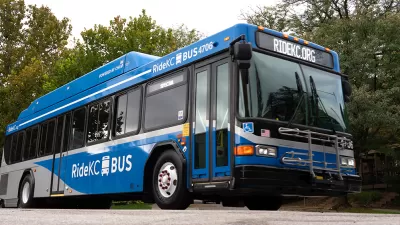A new last-mile service set to launch in February will connect the city's residents with job-rich suburbs.

"A new transportation service will attempt to provide a low-cost, on-demand connection between central city Milwaukee residents and Waukesha County employers," reports Jeramey Jannene.
The service, known as FlexRide Milwaukee, will pick up passengers at five locations and drop them off within two designated "employment zones" in an attempt to fill a gap in existing bus service. As Jannene writes, "the pilot study is being billed as a micro-transit effort that will attempt to bridge the spatial mismatch between residents on the north side of Milwaukee and suburban employers."
Milwaukee implemented a similar service on a fixed schedule, JobLines, in 2015, which was shut down in 2019. The Southeastern Wisconsin Regional Planning Commission (SEWRPC), which is leading the study along with UW-Milwaukee, hopes the new on-demand service will serve as a more effective connection for commuters.
When the service launches in February, riders will be able to request a ride by phone or using a mobile app. A similar effort is underway to provide the service in other nearby communities.
FULL STORY: New ‘Last Mile’ Solution Will Connect Suburban Employers, City Residents

Manufactured Crisis: Losing the Nation’s Largest Source of Unsubsidized Affordable Housing
Manufactured housing communities have long been an affordable housing option for millions of people living in the U.S., but that affordability is disappearing rapidly. How did we get here?

Americans May Be Stuck — But Why?
Americans are moving a lot less than they once did, and that is a problem. While Yoni Applebaum, in his highly-publicized article Stuck, gets the reasons badly wrong, it's still important to ask: why are we moving so much less than before?

Using Old Oil and Gas Wells for Green Energy Storage
Penn State researchers have found that repurposing abandoned oil and gas wells for geothermal-assisted compressed-air energy storage can boost efficiency, reduce environmental risks, and support clean energy and job transitions.

Updating LA’s Tree Rules Could Bring More Shade to Underserved Neighborhoods
A new USC study finds that relaxing Los Angeles’ outdated tree planting guidelines could significantly expand urban tree canopy and reduce shade disparities in lower-income neighborhoods, though infrastructure investments are also needed.

California's Canal Solar Projects Aim to Conserve Resources and Expand Clean Energy
California’s Project Nexus has begun generating electricity from solar panels installed over irrigation canals, with researchers and state agencies exploring statewide expansion to conserve water and boost clean energy production.

HHS Staff Cuts Gut Energy Assistance Program
The full staff of a federal program that distributes heating and cooling assistance for low-income families was laid off, jeopardizing the program’s operations.
Urban Design for Planners 1: Software Tools
This six-course series explores essential urban design concepts using open source software and equips planners with the tools they need to participate fully in the urban design process.
Planning for Universal Design
Learn the tools for implementing Universal Design in planning regulations.
Heyer Gruel & Associates PA
City of Moreno Valley
Institute for Housing and Urban Development Studies (IHS)
City of Grandview
Harvard GSD Executive Education
Salt Lake City
NYU Wagner Graduate School of Public Service
City of Cambridge, Maryland





























